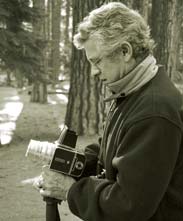


| Tom Artin |
 |
Born: November 12, 1938, Bloomington, Indiana
Education: Princeton University, BA, 1960, Ph. D., 1968, Comparative Literature
Tom Artin is a photographer and musician living in Rockland County, New York. His subjects range from landscapes, seascapes and cityscapes to portraits, florals and still lifes. His work is simple, straightforward and painterly. His eye for composition and understanding of the subject is matched by his attention to detail and craft. Artin began taking, developing and printing images in the early 1950s.
Artin's photographs are black and white and exploit the broad range of tonality and subtlety that medium affords. The majority of his photographs originate as medium format images shot on film with vintage Rolleiflexes and a Hasselblad, though he also works with 4"x5" and 8"x10" view cameras. In recent years, he has added digital cameras to his toolbox for certain applications. Artin continues to print in the traditional chemical darkroom. In the digital lightroom, he processes images scanned from negatives and transparencies in Photoshop, and prints onto water-color type papers via Conetech Piezography, a quad-tone digital black and white printing process developed for the Epson inkjet printers.
In the 1950's Artin outfitted his own dedicated dark-room at home, and devoted his high school senior chemistry project to the chemistry of photography, which included fabricating and printing on his own photographic paper. His photographic career ran in parallel with a career as medieval scholar and college teacher which he left in 1979 to pursue a full-time career as a jazz musician.
In recent decades, Artin's work has been primarily in the fine-art category, though he has done fashion and music photography for print and for websites.
Artin continues to travel around the world capturing light-rich studies of people and places; his studio, in the Bel-Ans center in Rockland County, serves also as his lightroom. He is currently on the roster of Bruce McGaw Graphic's artists, creating images for fine art posters sold around the world.
The florals currently offered by Ned Kelly & Co. were photographed with a Hasselblad on Agfa Scala (black and white transparency) film, processed in Photoshop, then printed via Piezography on an Epson 3000 ink-jet printer, using archival inks. The quad-tone process employs four varying intensities of black ink (replacing the conventional four colors) in order to achieve a nearly continuous and very broad tonal range. Printed on Hahnemühle William Turner archival paper, the photographs are matted in 100% cotton rag board, and framed in brushed aluminum Halbe frames.